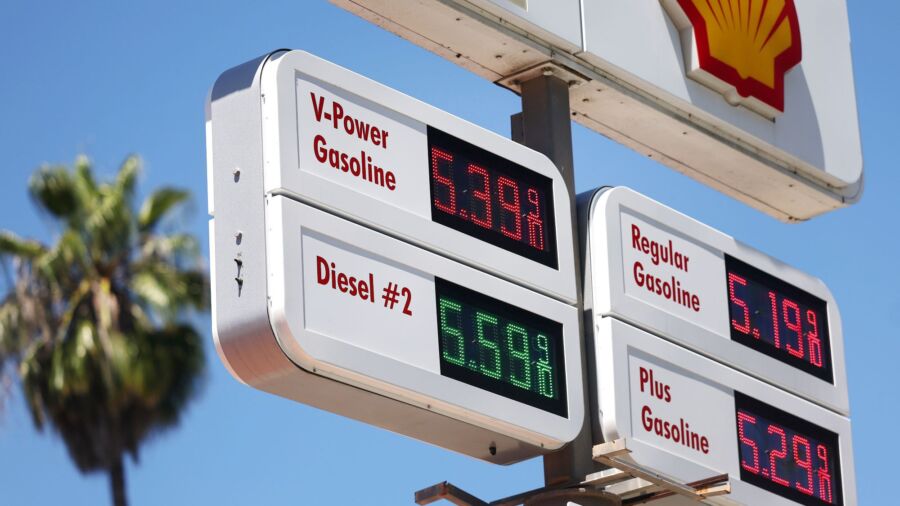U.S. oil prices shot above $90 a barrel for the first time in 10 months, a bad sign for the Federal Reserve.
The surge in oil prices is expected to push gasoline prices up even higher and worsen already rising inflation rates across the economy.
The latest jump in energy prices is beginning to reverse some of the efforts made by the central bank in its fight against inflation, which accelerated to 3.7 percent in August.
Prices at the pump are nearing their record high for the year, even though there has been a major drop in demand.
Despite the end of the peak summer driving season, gas prices, which were already a factor in pushing up inflation in August, will likely continue rising through next week because of the spike in oil prices.
Gas Rises as Oil Costs Soar Above $90
The national average for regular gasoline rose to $3.86 a gallon on Sept. 15, according to AAA, a six-cent jump from last week and 16 cents higher than the same day in 2022.
The same day, Brent crude, the global standard, traded above $94 per barrel, while West Texas Intermediate crude neared the $91 per barrel mark.
At least a dozen states have gas prices averaging $4 a gallon or higher, including Colorado, North Dakota, and California.
Two key inflation measures this week, which are closely followed by the Fed, showed fuel prices rise by more than expected in August.
The Bureau of Labor Statistics’ Consumer Price Index report and the Producer Price Index rose last month due to higher gas prices.
The CPI’s gasoline index jumped 10.6 percent in August, up sharply from the 0.2 percent gain in July, led by a 10.5 percent increase in demand.
The energy index overall increased by 5.6 percent last month.
President Joe Biden acknowledged the spike in gas prices, in a press statement on Sept. 13.
“Overall inflation has also fallen substantially over the last year, but I know last month’s increase in gas prices put a strain on family budgets. That’s why I remain laser-focused on cutting energy costs, including by investing in clean energy to bolster our energy security,” said the president.
His administration’s green energy policies have not helped matters, with the White House terminating oil drilling contracts on Federal lands in Alaska.
However, government officials have contacted oil and gas industry executives to ensure the security of supply.
“The Energy Department is in touch with producers and refiners to resolve any issues and to try to ensure stable supply,” the head of the White House Council of Economic Advisers, Jared Bernstein, told reporters.
Rep. Mark Green (R-Tenn.) told Fox Business that President Biden will politically pay a high price if gas prices rise above $4 a gallon in 2024.
OPEC Nations Maintain Production Cuts
The main cause of higher energy prices was driven by concerns over the security of global oil supplies.
Saudi Arabia and Russia shocked the market over a week ago by extending their aggressive supply cuts through the end of the year, despite an optimistic OPEC+ demand forecast.
The Saudis announced that oil supply cuts of 1 million barrels would be extended through the remainder of 2023 and would be reviewed monthly with the possibility of increases or decreases.
Russia’s Deputy Prime Minister Alexander Novak said on Sept. 12 that Moscow would reduce its exports by 300,000 barrels per day through the end of 2023.
The markets were then hit with another blow when major flooding in Libya raised concerns about a disruption in supply from the oil-exporting nation.
Libya produces about 1 million barrels of oil per day, according to OPEC, and is one of the key suppliers to a Europe already facing energy shortages due to sanctions on Russia.
The International Energy Agency’s (IEA) September report on the oil market projected that the Saudi and Russian oil cuts will ensure a “substantial” market deficit through the fourth fiscal quarter of 2023.
“Unwinding cuts at the start of 2024 would shift the balance to a surplus,” said the IEA report.
“However, oil stocks will be at uncomfortably low levels, increasing the risk of another surge in volatility that would be in the interest of neither producers nor consumers, given the fragile economic environment,” it said.
The IEA also forecasted peak oil demand before 2030, which OPEC immediately rejected.
OPEC said that consistent data-based forecasts showed that peak oil demand would not happen before 2030 and dismissed any claims for the “beginning of the end of fossil fuels.”
Meanwhile, China’s latest industrial output report, which showed faster-than-expected growth in August may lead to a further imbalance between supply and demand.
Energy Industry Experts Remain Optimistic
Industry analysts still remain hopeful that the brief reduction in refinery output over the past few months appears to be over while the nation prepares to switch to cheaper winter-grade gas and diesel.
“The national average hit some road bumps over the last week after starting to decline early in the week. The second half saw the national average rise as gas prices in the Corn Belt started spiking, pulling the average price in the U.S. along with it,” said Patrick De Haan, head of petroleum analysis at GasBuddy.
On the other hand, Mr. De Haan posted on X, formerly known as Twitter, that he disagreed with other estimates that “the national average is ‘set to cross above $4’ the rest of 2023. [M]aybe next year.”
He told Fox Business that he was still hopeful the country would “see an eventual decline” and projected that the national average could fall between $3.35 and $3.50 per gallon by the end of the year.
The GasBuddy analyst warned that “there’s a lot of wild cards” in play that could shift prices, which also “insinuated that if oil prices head lower, they may further raise the amount of the cuts or lengthen it.”
From The Epoch Times

